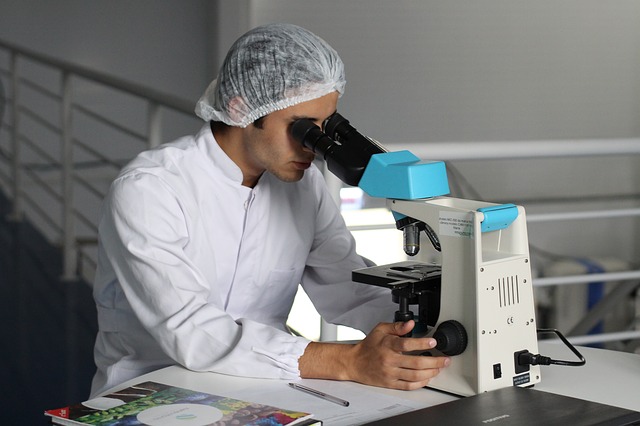Scientists investigate what makes a certain strain of yeast (S. Boulardii) probiotic.
Probiotics are normally taken after an antibiotic. The antibiotic kills most of the bacteria in your gut and the idea is to take a probiotic to repopulate your gut with friendly microorganisms that will help fight off the harmful bacteria. Probiotics are defined as live micro-organisms that confer a health benefit on the host. The word “microorganisms” is important because most probiotics are bacterial however there is one species of yeast (a fungus) that is used as a probiotic. Saccharomyces boulardii was originally isolated from litchis in Indochina. It is part of the Saccharomyces cerevisiae species (the yeast commonly used for baking and brewing). The probiotic properties are unique to S. Boulardii and it is the only yeast to have been evaluated for probiotic effects in double-blinded clinical trials. S. Boulardii exerts beneficial effects via two main mechanisms. It is cable of inhibiting certain bacterial toxins and their damaging effects. It also has immunostimulatory effects on the intestinal mucosa. Researchers were curious to know if this yeast was able to prevent the growth of harmful bacteria.
Boulardii produces a high amount of acetic acid
In a recent study published in Genome Research, researchers in Belgium wanted to know if S. Boulardii could prevent bacterial growth and what genes were responsible for this probiotic effect. The group assessed the antibacterial activity of twelve different strains of S. Boulardii and eleven strains of S. cerevisiae as controls. They did this by taking a drop of cell-free culture media from the yeast and placing it onto a surface where bacteria (Escherichia. coli MG1655) were growing in a petri-dish. They showed that three of the twelve S. Boulardii strains had antibacterial activity. The group identified acetic acid (the main ingredient in vinegar) as the component of the media that prevented bacterial growth. The scientists went on to show that all twelve of the S. Boulardii strains produced moderate to high amounts of acetic acid compared to S. cerevisiae. The amount of acetic acid reduced over time for the nine S. Boulardii strains that did not have an antimicrobial effect. The group concluded that these strains were able to consume the acetic acid when the concentrations rose.
The scientists then used genome sequencing to identify the genes that were responsible for both the production and utilization of acetic acid. The group found a mutation in the sdh1 gene in all the S. Boulardii strains that caused increased production of acetic acid. They were also able to identify a mutation in the whi2 gene which causes a defect in the ability to use acetic acid. This results in higher concentrations of acetic acid. Two copies of this mutation were essential for the defect in utilization to occur.
The group then went on to genetically engineer S. cerevisiae, the yeast that does not produce acetic acid. They introduced each of these mutations singly or in combination. They found that single mutants did not affect acetic acid production but in the introduction of all the mutations resulted in higher production of acetic acid. The researchers were able to use these mutations as a genetic fingerprint to differentiate between S. Boulardii from S. cerevisiae. They were the first to identify a genetic signature for S. Boulardii.
Prof. Thevelein, the principal investigator for this study explained in a press release, “We were able to find two unique mutations in S. boulardii that are responsible for the production of acetic acid. These mutations can act as a genetic ‘fingerprint’ that allows us to distinguish between these two types of yeast and allow the isolation and identification of new S. boulardii strains from nature.”
Although this research holds promise for identifying key characteristics of probiotic potency, some limitations need to be considered. The group only used a single bacterial strain to determine the probiotic effect. It would be important to determine the effect this high acetic acid production has on different strains of pathogenic bacteria. It would also be important to investigate what effect this will have on the commensal bacteria in the gut before it can be classified as probiotic.
Written by Tarryn Bourhill MSc, PhD Candidate.
References:
- Czerucka, D., Piche, T. & Rampal, P. yeast as probiotics–Saccharomyces boulardii. Alimentary pharmacology & therapeutics 26, 767-778 (2007).
-
Butel, M.-J. Probiotics, gut microbiota and health. Médecine et maladies infectieuses 44, 1-8 (2014).
-
Oelschlaeger, T. A. Mechanisms of probiotic actions–a review. International Journal of Medical Microbiology 300, 57-62 (2010).
-
Guarner, F. & Malagelada, J.-R. Gut flora in health and disease. The Lancet 361, 512-519 (2003).
-
Sears, C. L. A dynamic partnership: celebrating our gut flora. Anaerobe 11, 247-251 (2005).
-
Nuffel, M. V. Understanding probiotic yeast <https://www.eurekalert.org/pub_releases/2019-08/vfi-upy083019.php> (2019).
-
Offei, B., Vandecruys, P., De Graeve, S., Foulquié-Moreno, M. R. & Thevelein, J. M. Unique genetic basis of the distinct antibiotic potency of high acetic acid production in the probiotic yeast Saccharomyces cerevisiae var. boulardii. Genome Research (2019).
Image by luvqs from Pixabay



